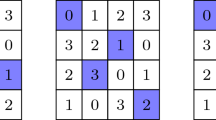Abstract
A subsquare of a Latin square L is a submatrix that is also a Latin square. An autotopism of L is a triplet of permutations (α, β, γ) such that L is unchanged after the rows are permuted by α, the columns are permuted by β and the symbols are permuted by γ. Let n!(n−1)!R n be the number of n×n Latin squares. We show that an n×n Latin square has at most n O(log k) subsquares of order k and admits at most n O(log n) autotopisms. This enables us to show that {ie11-1} divides R n for all primes p. We also extend a theorem by McKay and Wanless that gave a factorial divisor of R n , and give a new proof that R p ≠1 (mod p) for prime p.
Similar content being viewed by others
References
R. Alter: How many Latin squares are there?, Amer. Math. Monthly 82 (1975), 632–634.
R. A. Bailey: Latin squares with highly transitive automorphism groups, J. Aust. Math. Soc. 33 (1982), 18–22.
S. R. Blackburn, P. M. Neumann and G. Venkataraman: Enumeration of finite groups, Cambridge Tracts in Mathematics 173, Cambridge University Press, 2007.
J. Browning, P. Vojtěchovský and I. M. Wanless: Overlapping Latin subsquares and full products, Comment. Math. Univ. Carolin. 51 (2010), 175–184.
P. J. Cameron: Research problems from the BCC22, Discrete Math. 13 (2011), 1074–1083.
N. J. Cavenagh, C. Greenhill, and I. M. Wanless: The cycle structure of two rows in a random Latin square, Random Structures Algorithms 33 (2008), 286–309.
P. M. Cohn: Basic algebra: groups, rings, and fields, Springer, 2003.
K. Heinrich and W. D. Wallis: The maximum number of intercalates in a Latin square, Lecture Notes in Math. 884, Springer, 1981, 221–233.
A. Hulpke, P. Kaski, and P. R. J. Östergård: The number of Latin squares of order 11, Math. Comp. 80 (2011), 1197–1219.
D. Kotlar: Parity types, cycle structures and autotopisms of Latin squares, Electron. J. Combin. 19(3) (2012), P10.
B. Maenhaut, I. M. Wanless, and B. S. Webb: Subsquare-free Latin squares of odd order, European J. Combin. 28 (2007), 322–336.
B. D. McKay, A. Meynert, and W. Myrvold: Small Latin squares, quasigroups, and loops, J. Combin. Des. 15 (2007), 98–119.
B. D. McKay and I. M. Wanless: Most Latin squares have many subsquares, J. Combin. Theory Ser. A 86 (1999), 323–347.
B. D. McKay and I. M. Wanless: On the number of Latin squares: Ann. Comb. 9 (2005), 335–344.
B. D. McKay, I. M. Wanless and X. Zhang: The order of automorphisms of quasigroups, preprint.
G. L. Miller: On the n log n isomorphism technique: A preliminary report, Proc. Tenth Annual ACM Symposium on Theory of Computing, 1978, 51–58.
N. J. A. Sloane: The on-line encyclopedia of integer sequences. http://oeis.org/[oeis.org].
D. S. Stones: The parity of the number of quasigroups, Discrete Math. 21 (2010), 3033–3039.
D. S. Stones: On the Number of Latin Rectangles, PhD thesis, Monash University, 2010. http://arrow.monash.edu.au/hdl/1959.1/167114.
D. S. Stones: The many formulae for the number of Latin rectangles, Electron. J. Combin. 17 (2010), A1.
D. S. Stones, P. Vojtěchovský and I. M. Wanless: Cycle structure of autotopisms of quasigroups and Latin squares, J. Combin. Designs 20 (2012), 227–263.
D. S. Stones and I. M. Wanless: Compound orthomorphisms of the cyclic group, Finite Fields Appl. 16 (2010), 277–289.
D. S. Stones and I. M. Wanless: A Congruence Connecting Latin Rectangles and Partial Orthomorphisms, Ann. Comb. 16 (2012), 349–365.
D. S. Stones and I. M. Wanless: Divisors of the number of Latin rectangles, J. Combin. Theory Ser. A 117 (2010), 204–215.
D. S. Stones and I. M. Wanless: How not to prove the Alon-Tarsi Conjecture, Nagoya Math. J. 205 (2012), 1–24.
G. H. J. van Rees: Subsquares and transversals in Latin squares, Ars Combin. 29 (1990), 193–204.
Author information
Authors and Affiliations
Corresponding author
Additional information
Supported by ARC grants DP0662946 and DP1093320. Stones also partially supported by NSFC grant 61170301.
Rights and permissions
About this article
Cite this article
Browning, J., Stones, D.S. & Wanless, I.M. Bounds on the number of autotopisms and subsquares of a Latin square. Combinatorica 33, 11–22 (2013). https://doi.org/10.1007/s00493-013-2809-1
Received:
Published:
Issue Date:
DOI: https://doi.org/10.1007/s00493-013-2809-1



